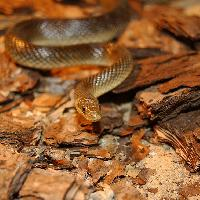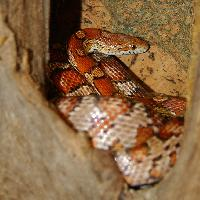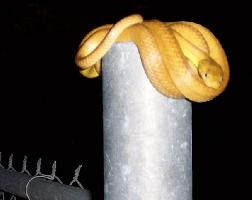
Poids et mesures
| Longueur | 120 cm |
|---|
Données biologiques
| Durée de vie | 10 r |
|---|
Description de l'animal
The Grass Snake (Natrix natrix), often referred to as the Ringed Snake or Water Snake, is a non-venomous reptile that is native to Europe and western Asia. This species is the largest snake in its range, displaying a remarkable adaptability to various habitats but showing a preference for wetland areas. Its presence is often an indicator of a healthy aquatic ecosystem.Physical Description:
Grass snakes are easily identifiable by their elongated, slender bodies, which are covered in smooth, glossy scales. They exhibit a distinctive color pattern, usually greenish, gray, or brown, with darker spots or streaks along their bodies, which helps them blend into their surroundings. A key identifying feature of the grass snake is the yellow and black collar located behind its head, which gives rise to the name "Ringed Snake." Adult grass snakes can reach lengths of up to 150 cm (59 inches), with females generally being larger than males.
Behavior and Diet:
Grass snakes are diurnal, meaning they are most active during the day. They are excellent swimmers and are often found near water bodies such as ponds, lakes, and rivers, where they hunt for their prey. Their diet primarily consists of amphibians, especially frogs and toads, but they also consume fish, small mammals, and even bird eggs. Grass snakes employ constriction to subdue their prey, although their non-venomous nature means they pose no threat to humans.
Reproduction:
Grass snakes are oviparous, laying clutches of 10 to 40 eggs during the summer, which they deposit in warm, humid locations such as compost heaps or rotting vegetation to incubate. The eggs hatch after about 40 to 60 days, with the young snakes being fully independent from birth. They reach sexual maturity in two to three years, with a lifespan that can extend up to 15 years in the wild.
Conservation Status:
The grass snake is considered to be of least concern by the International Union for Conservation of Nature (IUCN), although its populations are facing threats from habitat destruction, pollution, and road mortality. Conservation efforts are focused on preserving their natural habitats and mitigating the impacts of human activities.
In summary, the grass snake is a fascinating and beneficial species, playing a crucial role in controlling amphibian populations and indicating the health of wetland ecosystems. Its non-threatening nature and distinctive appearance make it an interesting subject of study and observation for herpetologists and nature enthusiasts alike.
Animaux similaires
Nouvelles photos d'animaux
Top 10 des animaux
- Dolphin gull (Leucophaeus scoresbii)
- Japanese macaque (Macaca fuscata)
- Stone loach (Barbatula barbatula)
- Greek tortoise (Testudo graeca)
- Russian tortoise (Testudo horsfieldii)
- Galápagos tortoise (Geochelone nigra complex)
- Diana monkey (Cercopithecus diana)
- Moustached guenon (Cercopithecus cephus)
- Common flying dragon (Draco volans)
- Galápagos penguin (Spheniscus mendiculus)


